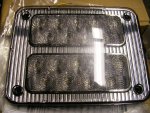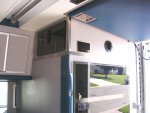rlrenz
Explorer
COUNT YOUR BLESSINGS!
I'm part of an emergency vehicle upfitter's group - those guys who add equipment to LE vehicles like emergency lighting, K9 kennels, radios, etc. The most common questions we ask each other usually are "where can I connect to a park-sense line..." or similar. All the vehicles being set up as LE (law enforcement) vehicles have become 99.9% computer-based - the old days of just tapping into something are long gone.
The group references the various manufacturer's upfitter guides regularly, but the many voids in the manual mean we have to work with each other to figure out a solution.
Emergency lighting is now computer controlled, radio antenna holes need to fall into a specific location, side mounted spotlights are going through heat treated body sections (hole saw killers!).
A car that has been ordered with a police package has different connector locations than a standard vehicle, but PDs regularly convert a spare "civilian" car to PD usage.
The installation of a LE equipment package can easily take an experienced installer 2-3 days.
And that is why I am very glad that the medium trucks that we convert to RVs are old enough that they aren't entirely computer based. The only computers in my 1999 Freightliner / Medic Master are for the engine and the Anti-Lock brake system.
If your module (ambulance portion) is set up for conventional relay-diode control with toggle switches, you have a system that can be repaired with a couple bucks worth of parts - but if your system is controlled by a proprietary system (such as the Horton Intelliplex), any parts or programming changes become complicated quickly. If you use the Weldon V-MUX system, plan on sticker shock if you need a new touch screen module ($2000 or so) or a connection node ($900 or so).
And if the manufacturer of your system is out of business (or if they won't support legacy equipment), then you have a challenge/problem/disaster to deal with.
I'm part of an emergency vehicle upfitter's group - those guys who add equipment to LE vehicles like emergency lighting, K9 kennels, radios, etc. The most common questions we ask each other usually are "where can I connect to a park-sense line..." or similar. All the vehicles being set up as LE (law enforcement) vehicles have become 99.9% computer-based - the old days of just tapping into something are long gone.
The group references the various manufacturer's upfitter guides regularly, but the many voids in the manual mean we have to work with each other to figure out a solution.
Emergency lighting is now computer controlled, radio antenna holes need to fall into a specific location, side mounted spotlights are going through heat treated body sections (hole saw killers!).
A car that has been ordered with a police package has different connector locations than a standard vehicle, but PDs regularly convert a spare "civilian" car to PD usage.
The installation of a LE equipment package can easily take an experienced installer 2-3 days.
And that is why I am very glad that the medium trucks that we convert to RVs are old enough that they aren't entirely computer based. The only computers in my 1999 Freightliner / Medic Master are for the engine and the Anti-Lock brake system.
If your module (ambulance portion) is set up for conventional relay-diode control with toggle switches, you have a system that can be repaired with a couple bucks worth of parts - but if your system is controlled by a proprietary system (such as the Horton Intelliplex), any parts or programming changes become complicated quickly. If you use the Weldon V-MUX system, plan on sticker shock if you need a new touch screen module ($2000 or so) or a connection node ($900 or so).
And if the manufacturer of your system is out of business (or if they won't support legacy equipment), then you have a challenge/problem/disaster to deal with.




